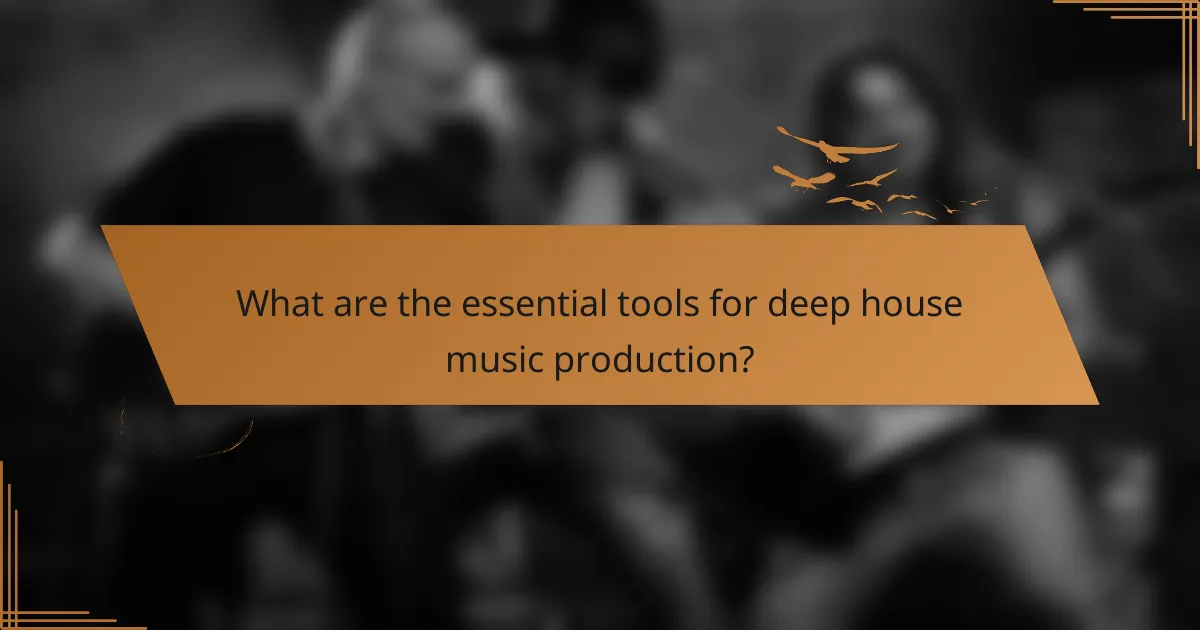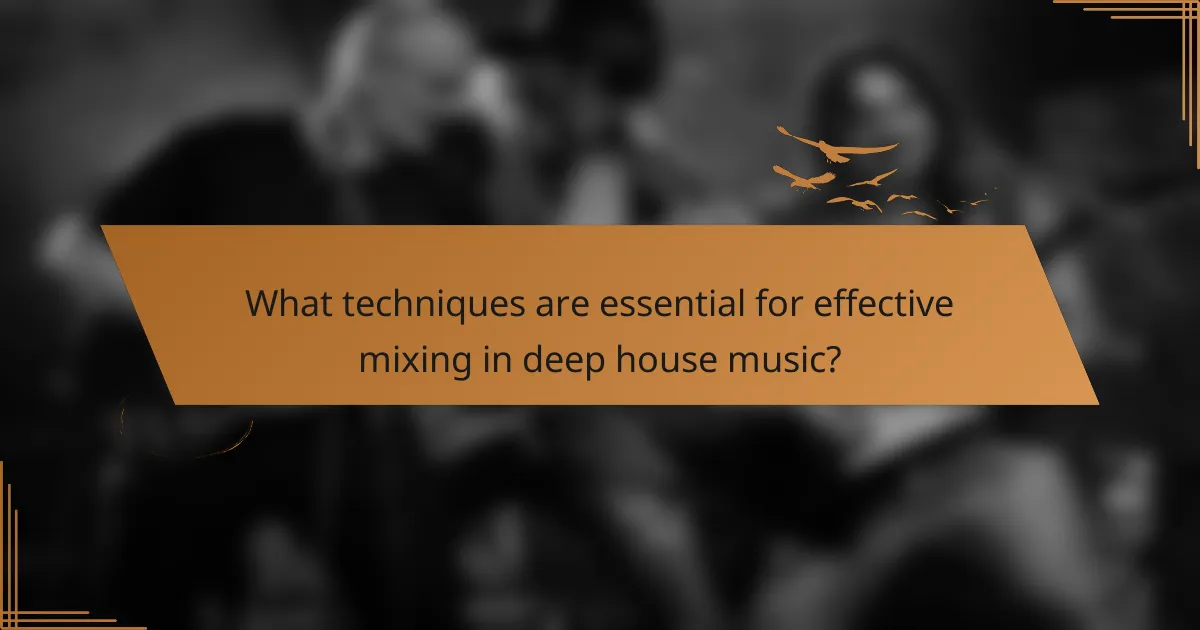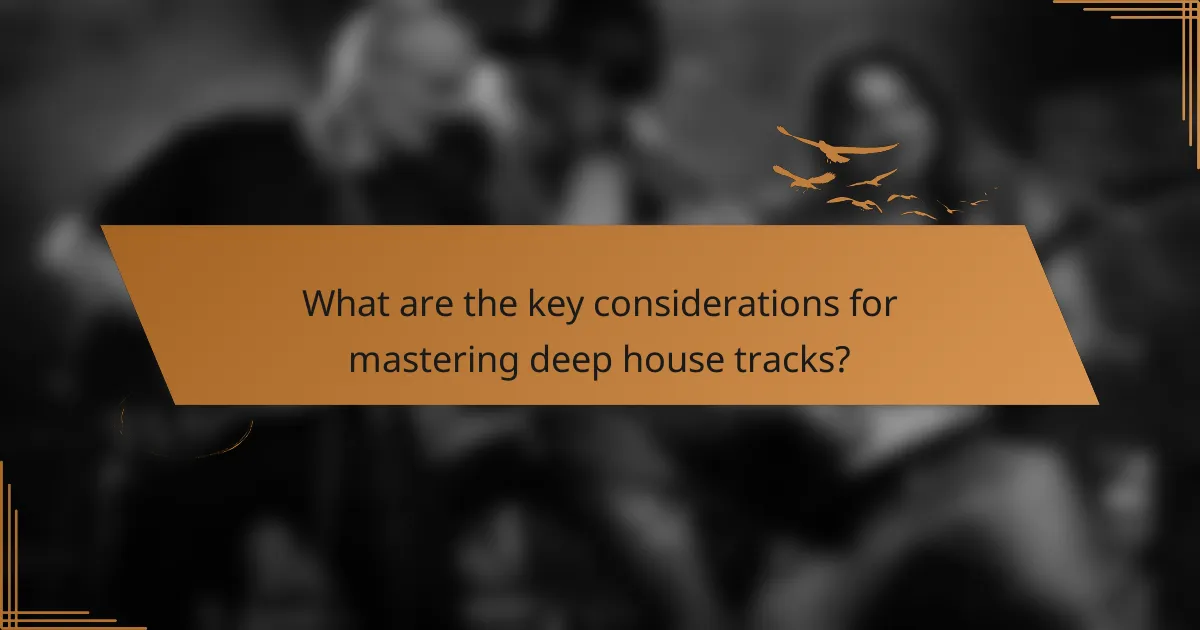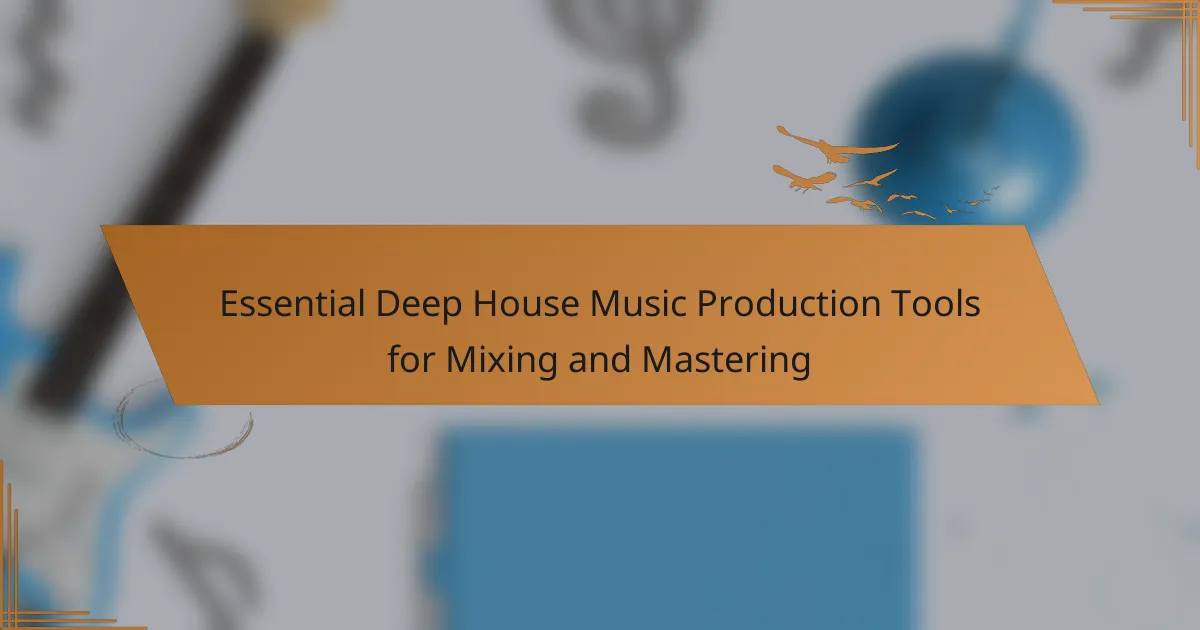Deep house music production relies on essential tools such as digital audio workstations (DAWs), synthesizers, drum machines, and audio plugins. Key DAWs for this genre include Ableton Live, FL Studio, and Logic Pro, while popular synthesizers like Serum and Massive contribute unique sounds. Effective mixing techniques involve balancing levels, using EQ, and applying compression to achieve clarity and depth. Mastering considerations focus on loudness, dynamic range, and frequency balance to ensure a professional sound. This article provides a comprehensive overview of these tools and techniques critical for producing high-quality deep house tracks.

What are the essential tools for deep house music production?
The essential tools for deep house music production include a digital audio workstation (DAW), synthesizers, drum machines, and audio plugins. A DAW is crucial for recording, editing, and arranging music. Popular DAWs for deep house include Ableton Live, FL Studio, and Logic Pro. Synthesizers generate unique sounds and textures, with options like Serum and Massive being widely used. Drum machines provide rhythmic elements, with classic models like the Roland TR-808 and TR-909 being iconic in deep house. Audio plugins enhance sound quality, with effects such as reverb, delay, and EQ being essential for mixing and mastering. These tools collectively enable producers to create professional-sounding deep house tracks.
How do these tools contribute to mixing and mastering?
Mixing and mastering tools enhance audio quality and balance in music production. They help in adjusting levels, panning, and equalization of different audio tracks. Tools such as equalizers allow for frequency adjustments, ensuring clarity in sound. Compressors control dynamic range, making loud sounds softer and soft sounds louder. Reverb and delay add depth and space to the mix. These tools also facilitate the final polish in mastering, ensuring tracks are cohesive and ready for distribution. The use of these tools is essential for achieving professional sound quality in deep house music production.
What specific functionalities do these tools provide?
These tools provide functionalities for audio editing, sound design, and mixing. They allow users to manipulate audio tracks with precision. Features include equalization, compression, and reverb effects. Users can layer sounds to create depth and complexity. Many tools offer MIDI support for virtual instruments. They also provide automation capabilities for dynamic changes. Some tools include built-in sound libraries for quick access to samples. Overall, these functionalities enhance the music production process significantly.
How do different tools interact during the production process?
Different tools interact during the production process by integrating various functionalities to create a cohesive workflow. Digital Audio Workstations (DAWs) serve as the central hub, allowing users to arrange, edit, and mix audio tracks. Plugins, such as synthesizers and effects, enhance the sound by adding layers and modifying audio characteristics. Hardware tools like MIDI controllers provide tactile input, enabling precise control over software instruments.
Audio interfaces facilitate the connection between microphones, instruments, and the DAW, ensuring high-quality sound capture. Collaboration between these tools allows producers to manipulate sound creatively and efficiently. For example, a MIDI controller can trigger a synthesizer plugin within the DAW, while an audio interface captures the final mix for mastering.
The interaction of these tools is essential for achieving professional sound quality in deep house music production. Each tool complements the others, creating a seamless production experience.
What types of software are commonly used in deep house music production?
Digital Audio Workstations (DAWs) are commonly used in deep house music production. Popular DAWs include Ableton Live, FL Studio, and Logic Pro X. These platforms provide essential tools for arranging, mixing, and mastering tracks. Ableton Live is favored for its session view, which allows for flexible live performance. FL Studio is known for its user-friendly interface and powerful sequencing capabilities. Logic Pro X offers a comprehensive suite of virtual instruments and effects. Additionally, plugins such as Serum and Massive are frequently used for sound design in deep house. These tools enable producers to create rich, textured sounds characteristic of the genre.
What are the key features to look for in a digital audio workstation (DAW)?
Key features to look for in a digital audio workstation (DAW) include audio recording capabilities, MIDI support, and a user-friendly interface. A DAW should allow for multi-track recording, enabling users to capture multiple audio sources simultaneously. MIDI support is essential for composing and editing music using virtual instruments. A user-friendly interface enhances workflow efficiency and reduces the learning curve. Additionally, built-in effects and plugins expand creative possibilities. Compatibility with various audio formats ensures flexibility in project sharing. Finally, robust export options facilitate the finalization of music projects. These features collectively contribute to an effective and versatile DAW for music production.
How do plugins enhance the mixing and mastering process?
Plugins enhance the mixing and mastering process by providing specialized tools for sound manipulation. They allow for precise adjustments to EQ, compression, and reverb. This results in a polished and professional sound. Plugins can emulate analog gear, adding warmth and character to digital recordings. They also offer visual feedback, making it easier to identify frequency issues. Many plugins include presets that speed up workflow and inspire creativity. The use of plugins can significantly improve the overall sonic quality of a track. According to a survey by Sound on Sound, 85% of audio engineers rely on plugins for mixing and mastering tasks.
What hardware is crucial for deep house music production?
A digital audio workstation (DAW) is crucial for deep house music production. It serves as the central hub for composing, recording, and editing music. Popular DAWs for this genre include Ableton Live and FL Studio. Audio interfaces are also essential. They enhance sound quality and facilitate connections between instruments and computers. MIDI controllers are important for creating melodies and beats. They allow for hands-on control of software instruments. Studio monitors provide accurate sound reproduction. They enable producers to make informed mixing decisions. A good microphone is necessary for recording vocals and live instruments. Each of these hardware components plays a vital role in the production process, ensuring high-quality deep house tracks.
How do studio monitors impact the mixing process?
Studio monitors significantly influence the mixing process by providing accurate sound reproduction. They allow producers to hear audio clearly and make informed mixing decisions. Accurate frequency response helps identify tonal imbalances in tracks. This clarity aids in balancing levels and panning instruments effectively. Studio monitors also reveal details in the audio that standard speakers may mask. This detail is crucial for making precise adjustments. Furthermore, the flat response of studio monitors minimizes coloration of sound. This ensures mixes translate well across various playback systems. In essence, studio monitors are essential for achieving professional-quality mixes.
What role does an audio interface play in production quality?
An audio interface significantly impacts production quality by converting analog signals to digital. This conversion is crucial for recording instruments and vocals. High-quality audio interfaces offer better converters, resulting in clearer sound. They also reduce latency, allowing for real-time monitoring during recording. Moreover, an audio interface provides professional-grade inputs and outputs. This enhances the overall sound fidelity. Research indicates that better interfaces can improve the dynamic range and frequency response. Thus, an audio interface is essential for achieving high production quality in music.

What techniques are essential for effective mixing in deep house music?
Essential techniques for effective mixing in deep house music include balancing levels, using EQ, and applying compression. Balancing levels ensures that each element is heard clearly in the mix. EQ helps to carve out space for each sound, reducing frequency clashes. Compression controls dynamic range, making sounds more consistent. Additionally, using reverb creates a sense of space, enhancing the overall atmosphere. Panning instruments adds width to the mix, allowing for a fuller sound. Finally, referencing tracks in a similar genre aids in achieving a professional sound. These techniques are fundamental in achieving clarity and depth in deep house music mixes.
How can EQ be effectively utilized in mixing?
EQ can be effectively utilized in mixing by adjusting frequency ranges to enhance clarity and balance. It allows producers to cut unwanted frequencies and boost desirable ones. For example, reducing low frequencies can help prevent muddiness in a mix. Boosting mid frequencies can enhance vocal presence. Each instrument occupies a specific frequency range, and EQ helps carve out space for each element. This technique is crucial in deep house music to maintain a clean and dynamic sound. Proper EQ usage can lead to a more polished and professional final mix.
What are the common EQ strategies for deep house tracks?
Common EQ strategies for deep house tracks include cutting low frequencies, boosting mid-range presence, and using high-pass filters. Cutting low frequencies around 20-30 Hz prevents muddiness in the mix. Boosting mid-range frequencies between 1 kHz and 3 kHz enhances vocal clarity and instrument definition. High-pass filters are often applied to synths and pads to maintain clarity. Additionally, using a gentle low shelf boost around 60-100 Hz can add warmth without overwhelming the mix. These strategies help create a balanced and dynamic sound characteristic of deep house music.
How does frequency balancing affect the overall sound?
Frequency balancing directly influences the clarity and depth of overall sound. It ensures that no single frequency range overwhelms others, creating a more harmonious mix. Proper frequency balancing allows each instrument and vocal to occupy its own space in the mix. This results in a cleaner sound that is easier for listeners to enjoy. A well-balanced frequency spectrum enhances the emotional impact of the music. It prevents muddiness and harshness, which can detract from the listening experience. Studies show that music with balanced frequencies is perceived as more professional and pleasing. Therefore, frequency balancing is essential for achieving high-quality sound in music production.
What is the importance of compression in mixing?
Compression is crucial in mixing as it controls the dynamic range of audio signals. It ensures that louder sounds do not overpower softer ones. This results in a more balanced and cohesive mix. Compression enhances the presence of individual tracks within a mix. It also allows for increased loudness without distortion. By reducing peaks, compression helps maintain clarity and definition. Proper use of compression can improve the overall energy of a track. Studies show that effective compression techniques can significantly enhance listener engagement.
How can compression enhance the dynamics of a deep house track?
Compression enhances the dynamics of a deep house track by controlling the dynamic range. It reduces the volume of the loudest parts while boosting quieter sections. This creates a more balanced and polished sound. Compression can add sustain to elements like bass and vocals. It helps to glue different elements together, making the mix cohesive. Additionally, it can increase the perceived loudness of the track without distortion. Effective use of compression results in a more engaging listening experience. Studies show that well-compressed tracks are often more enjoyable and impactful for listeners.
What are common compression settings for deep house music?
Common compression settings for deep house music typically include a ratio of 3:1 to 6:1. Attack times are often set between 10 to 30 milliseconds. Release times usually range from 50 to 100 milliseconds. Threshold settings generally fall between -10 dB to -20 dB. Make-up gain is adjusted to match the output level. These settings help achieve a balanced and punchy sound. The use of these parameters is common in the deep house genre to maintain groove and energy.
What mixing techniques are specific to deep house music?
Deep house music employs specific mixing techniques that enhance its unique sound. Key techniques include the use of EQ to create space between elements. This allows bass and kick drums to coexist without clashing. Additionally, reverb is used to create depth and atmosphere. This technique contributes to the genre’s immersive quality. Sidechain compression is also prevalent in deep house. It allows the kick drum to cut through the mix, providing rhythmic clarity. Another technique is layering sounds to create rich textures. This approach adds complexity to the overall mix. Finally, automation is frequently used to build tension and dynamics throughout the track. These techniques are essential for achieving the signature deep house sound.
How does reverb contribute to the depth of a track?
Reverb contributes to the depth of a track by simulating the natural reflections of sound in a space. It creates a sense of distance and ambiance. This effect allows individual elements to blend more seamlessly within the mix. When applied correctly, reverb can enhance the spatial perception of instruments and vocals. It can make sounds feel like they are coming from various distances. For example, a vocal track with reverb may sound closer or farther away depending on the settings used. Additionally, different types of reverb can create unique textures. Plate reverb, for instance, adds warmth, while hall reverb can evoke a grander space. Overall, reverb is essential for achieving a rich, immersive listening experience in deep house music.
What are the best practices for panning in deep house music?
Best practices for panning in deep house music include creating a balanced stereo image. Panning elements like hi-hats and percussion slightly to the left or right can enhance spatial perception. Bass and kick drums typically remain centered for a solid foundation. Vocals can be panned subtly to avoid masking other elements while maintaining clarity. Using automation for dynamic panning can add movement and interest to the mix. Reference tracks in the genre can guide effective panning decisions. Consistent monitoring on various systems ensures the mix translates well across different playback environments.

What are the key considerations for mastering deep house tracks?
The key considerations for mastering deep house tracks include achieving proper loudness, maintaining dynamic range, and ensuring frequency balance. Loudness should be optimized to fit within industry standards without sacrificing sound quality. Dynamic range is important to preserve the track’s emotional impact while preventing distortion. Frequency balance ensures that bass, mids, and highs are well represented, creating a full and engaging sound. Additionally, stereo imaging should be addressed to create a sense of space and depth in the mix. Finally, using reference tracks can provide a benchmark for quality and help guide the mastering process.
How does mastering differ from mixing?
Mastering and mixing are distinct processes in music production. Mixing involves combining individual audio tracks into a cohesive whole. It focuses on adjusting levels, panning, and effects for each track. Mastering, on the other hand, is the final step before distribution. It ensures the overall sound is polished and balanced across all playback systems. Mastering also involves applying compression, EQ, and limiting to the mixed track. The goal of mastering is to enhance the mix and prepare it for release. Mixing shapes the individual elements, while mastering finalizes the complete track.
What are the typical steps involved in the mastering process?
The typical steps involved in the mastering process include preparation, equalization, compression, limiting, and finalizing. Preparation involves organizing and analyzing the mix. Equalization adjusts frequency balances for clarity and tonal balance. Compression controls dynamics, ensuring consistent volume levels. Limiting prevents clipping and maximizes loudness without distortion. Finalizing includes formatting and exporting the master for distribution. Each step enhances the overall sound quality and ensures the track meets industry standards.
How does loudness affect the final product?
Loudness significantly influences the final product in music production. It affects how the track is perceived by listeners. A louder track can create a sense of energy and impact. Conversely, excessive loudness may lead to distortion and loss of dynamic range. The loudness level can also influence competitive positioning in streaming platforms. Research shows that tracks with higher loudness levels tend to perform better in terms of listener engagement. This is due to the psychological impact of volume on human perception. Consequently, balancing loudness while maintaining audio quality is crucial in mixing and mastering.
What tools are essential for mastering deep house music?
Essential tools for mastering deep house music include digital audio workstations (DAWs), equalizers, compressors, and limiters. DAWs like Ableton Live or FL Studio provide a platform for arranging and editing tracks. Equalizers allow for frequency adjustments, enhancing clarity and balance in the mix. Compressors help control dynamic range, ensuring a consistent sound. Limiters prevent clipping by controlling the audio peaks. Additionally, reference tracks are vital for comparison, helping to achieve a professional sound. Quality studio monitors and headphones are crucial for accurate sound reproduction during the mastering process. Together, these tools form a comprehensive setup for mastering deep house music effectively.
How do limiters and maximizers function in the mastering chain?
Limiters and maximizers control the dynamic range of audio in the mastering chain. Limiters prevent audio signals from exceeding a set threshold, ensuring no clipping occurs. They achieve this by reducing the level of peaks in the audio signal. This results in a more consistent volume level throughout the track. Maximizers enhance the perceived loudness of the audio. They do this by applying a combination of limiting and psychoacoustic techniques. This process allows the track to sound louder without distortion. Both tools are essential for achieving a polished and competitive sound in music production. Their roles are critical in preparing a track for distribution across various platforms.
What role does metering play in achieving a polished sound?
Metering is crucial for achieving a polished sound in music production. It provides visual feedback on levels, dynamics, and frequency content. Accurate metering helps identify issues like clipping or imbalances in the mix. This ensures that all elements sit well together in the final output. Various metering tools, such as LUFS meters and spectrum analyzers, guide producers in making informed decisions. These tools help maintain consistency and clarity across different playback systems. Proper metering leads to a professional and polished sound that meets industry standards. Thus, effective use of metering is essential in the mixing and mastering process.
What common mistakes should be avoided during mastering?
Common mistakes to avoid during mastering include over-compression, excessive equalization, and neglecting reference tracks. Over-compression can lead to a loss of dynamic range. This diminishes the overall impact of the track. Excessive equalization may result in an unbalanced frequency spectrum. This can cause certain elements to become muddy or overly harsh. Neglecting reference tracks prevents proper context for sound quality. Using reference tracks helps in achieving a professional sound. Ignoring loudness standards can lead to a track that is either too quiet or overly loud. This can affect playback across different platforms. Finally, failing to take breaks can impair judgment. Continuous listening can lead to ear fatigue, affecting decision-making.
How can over-compression ruin a track’s quality?
Over-compression can ruin a track’s quality by flattening its dynamic range. This results in a loss of clarity and detail. When a track is overly compressed, softer sounds become indistinguishable from louder ones. This can lead to a lifeless sound that lacks emotional impact. Additionally, over-compression can introduce unwanted artifacts. These artifacts can manifest as distortion or pumping effects. Such issues detract from the overall listening experience. Research shows that dynamic range compression should be applied judiciously to maintain audio integrity.
What are the signs of a poorly mastered track?
Signs of a poorly mastered track include a lack of clarity, excessive distortion, and imbalanced frequency response. A poorly mastered track often sounds muddy, making it hard to distinguish individual elements. Additionally, it may have inconsistent loudness levels, leading to abrupt changes in volume. Over-compression can cause a lifeless sound, while under-compression may leave dynamics too pronounced. Poor stereo imaging results in a flat soundstage, lacking depth and width. Finally, a poorly mastered track may not translate well across different playback systems, sounding different on headphones versus speakers. These signs indicate that the track did not undergo a professional mastering process.
What are some best practices for mixing and mastering deep house music?
Best practices for mixing and mastering deep house music include balancing levels, using EQ effectively, and applying compression. Balancing levels ensures that each element sits well in the mix. This involves adjusting volume faders so that no single instrument overwhelms others. Effective EQ helps to carve out space for each sound. For example, cutting unnecessary low frequencies can prevent muddiness. Compression controls dynamics, making sounds more consistent. It can be particularly useful on kick drums and basslines to maintain energy.
Additionally, using reverb and delay can enhance depth and space in the mix. These effects should be applied judiciously to avoid a cluttered sound. Monitoring on multiple systems is crucial. This practice ensures that the mix translates well across different playback devices. Finally, referencing professional tracks can provide guidance on achieving a polished sound. Following these practices can lead to a well-rounded deep house track.
The main entity of the article is essential tools for deep house music production, specifically focusing on mixing and mastering. The article outlines the critical components required for effective music production, including digital audio workstations (DAWs), synthesizers, drum machines, audio plugins, and hardware like audio interfaces and MIDI controllers. It discusses their functionalities, how they interact during the production process, and the importance of mixing techniques such as EQ, compression, and reverb. Additionally, the article highlights key considerations for mastering deep house tracks, emphasizing the significance of loudness, dynamic range, and frequency balance to achieve a professional sound quality.
